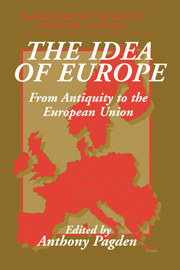Book contents
- Frontmatter
- Contents
- Acknowledgments
- Introduction
- 1 Europe: Conceptualizing a Continent
- 2 Some Europes in Their History
- 3 “Europe” in the Middle Ages
- 4 The Republican Mirror: The Dutch Idea of Europe
- 5 The Napoleonic Empire and the Europe of Nations
- 6 Homo Politicus and Homo Oeconomicus: The European Citizen According to Max Weber
- 7 The European Self: Rethinking an Attitude
- 8 European Nationalism and European Union
- 9 From the Ironies of Identity to the Identities of Irony
- 10 Muslims and European Identity: Can Europe Represent Islam?
- 11 The Long Road to Unity: The Contribution of Law to the Process of European Integration since 1945
- 12 The Euro, Economic Federalism, and the Question of National Sovereignty
- 13 Identity Politics and European Integration: The Case of Germany
- 14 Nationalisms in Spain: The Organization of Convivencia
- 15 The Kantian Idea of Europe: Critical and Cosmopolitan Perspectives
- Contributors
- Index
- Cambridge Cultural Social Studies
4 - The Republican Mirror: The Dutch Idea of Europe
Published online by Cambridge University Press: 14 July 2009
- Frontmatter
- Contents
- Acknowledgments
- Introduction
- 1 Europe: Conceptualizing a Continent
- 2 Some Europes in Their History
- 3 “Europe” in the Middle Ages
- 4 The Republican Mirror: The Dutch Idea of Europe
- 5 The Napoleonic Empire and the Europe of Nations
- 6 Homo Politicus and Homo Oeconomicus: The European Citizen According to Max Weber
- 7 The European Self: Rethinking an Attitude
- 8 European Nationalism and European Union
- 9 From the Ironies of Identity to the Identities of Irony
- 10 Muslims and European Identity: Can Europe Represent Islam?
- 11 The Long Road to Unity: The Contribution of Law to the Process of European Integration since 1945
- 12 The Euro, Economic Federalism, and the Question of National Sovereignty
- 13 Identity Politics and European Integration: The Case of Germany
- 14 Nationalisms in Spain: The Organization of Convivencia
- 15 The Kantian Idea of Europe: Critical and Cosmopolitan Perspectives
- Contributors
- Index
- Cambridge Cultural Social Studies
Summary
In 1622 Pieter de la Court, who was both a cloth manufacturer in Leiden and, together with his brother Johann, one of the most influential political and economic theorists of the seventeenth century, set out the principles of the Interests of Holland and West-Friesland in the book that bore this title. In it he described the political institutions and policy aims of the Dutch predominantly in terms of the economic conditions of their society. Profitable occupations, thriving markets, and a numerous population were among the main attributes of what he believed to be the “welfare of the people.” The main sources of welfare were, he believed, to be found in fishing and trade, and in particular maritime trade. These occupations were well suited to the actual conditions of the Low Countries, provided an income for many, and attracted people from abroad to add to the population, thereby helping to establish the conditions for even greater welfare. The political institutions appropriate to sustain this economy could be easily summarized as religious tolerance and responsible government.
De la Court maintained that the freedom of the individual was essential to promote profitable economic activities, since only by consulting one's self-interest would citizens be able to make the right choices. The epitome of freedom is to have the opportunity to think for oneself and to learn from one's mistakes. Religious dogmatism frustrates such a development, while bringing the church's interference with the proper ways of politics in its wake.
- Type
- Chapter
- Information
- The Idea of EuropeFrom Antiquity to the European Union, pp. 91 - 115Publisher: Cambridge University PressPrint publication year: 2002
- 10
- Cited by

